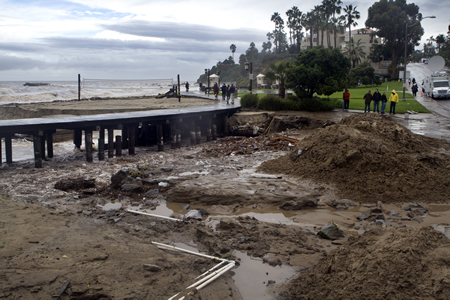
By now most people know that weather forecasters are predicting one of the largest El Niño’s on record, perhaps rivaling the storms of 1982-1983 and 1997-1998. Even the latest storm in 2010 caused heavy flooding damage to properties and infrastructure around Laguna Beach.
Are you prepared? Not with floodgates and sandbags, but with flood insurance.
The most important thing to know is that if you currently do not have flood coverage there is a 30-day waiting period before coverage begins. So as you read this today on Friday, Nov. 13, any coverage would be effective Dec. 13, according to John Campbell, owner of John L. Campbell Insurance Agency, Inc. located in Laguna Beach. “The only exception is for properties that are currently in escrow for purchase or sale, then the coverage is immediate,” he said.
A trove of information on the National Flood Insurance Program (NFIP) is available for those interested in learning more, especially now with the weather pattern season closing in quickly. A quick review of the site however, reveals some important must know items.
The NFIP is a 100 percent federally-backed government program, which is “aimed at reducing the impact of flooding on private and public structures,” according to the NFIP website. The hallmark of the initiative, which was passed by Congress in 1968 is the provision for property owners and even renters to purchase affordable flood insurance protection.
“Flood insurance policies are separate and distinct from homeowner insurance policies,” said Campbell. Also important to know, a flood policy is available for purchase by those living in a designated Federal Emergency Management (FEMA) flood plain, or outside of one.
The determination of a property’s risk factor for flooding is made in the context of a Flood Insurance Rate Map (FIRM), which delineates specific flood zones. “These digital flood hazard maps provide an official depiction of flood hazards for each community and for properties located within it,” according to NFIP site.
Laguna Beach is one of over 22,000 communities to have an official FIRM map, along with agreeing to “adopt and enforce floodplain management ordinances to reduce future flood losses by regulating new construction in high flood-risk areas,” the NFIP site indicated.
A Laguna resident can access the FEMA flood map using a specific address to ascertain what zone a property falls under. There are multiple zone designations, but broadly the categories are marked by risk categorization, from low risk to high risk. The high-risk areas are indicated as Special Flood Hazard Area (SFHA) and carry “at least a 1 in 4 chance of flooding during a 30-year mortgage,” according to NFIP. A moderate to low-risk area is labeled as a Non-Special Flood Hazard Area (NSFHA).
For a property owner with a commercial or residential mortgage, the lender will require flood insurance depending on the determination of risk and zone as read on the FIRM map.
That said, even if a lender does not require coverage, the property owner may choose to purchase coverage to safeguard the structure and contents. According to NFIP, “people outside of mapped high-risk flood areas file over 20 percent of all National Flood Insurance Program flood insurance claims and receive one-third of Federal Disaster Assistance for flooding.
“I recently had a client owning two properties without mortgages, who declined flood coverage, as he determined he would be safe in the event of flooding,” said Campbell. “Each property owner needs to decide for themselves, but we have paid claims on homes on the hillsides of Laguna Beach that did not require coverage, but the owner opted to have it.”
From a financial perspective it is critical to note that the maximum coverage on a structure that will be covered by a flood plan is $250,000. Additionally, owners or renters can purchase personal property protection. While there are a variety of factors associated with the pricing of a policy including: year of construction, number of floors, occupancy, elevation and others; Campbell indicated that for a residential unit an average figure would fall in the $400-$500 range, but was quick to point out that each policy will have its own pricing.
Owners and renters in Laguna who do not currently have flood insurance coverage can consider the pros and cons by talking to their local insurance agent, and by visiting: floodsmart.gov/floodsmart.




